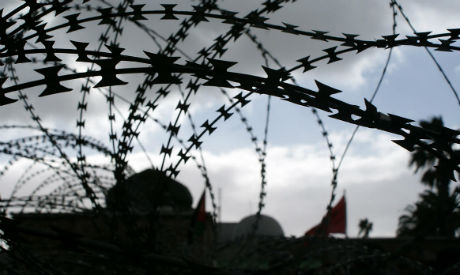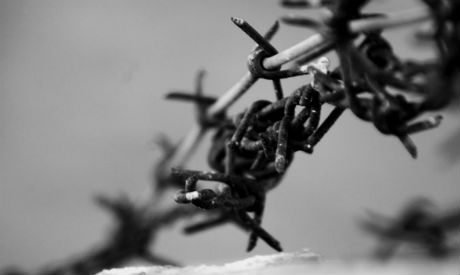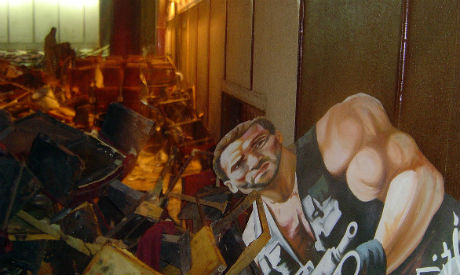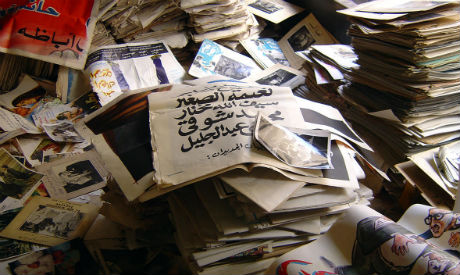Jordanian photographer and theatre director Raed Asfour launched his photo exhibition Barbed Wire on 30 September at Beit El-Sura, one of Cairo's several photography hubs. The works will remain on display until 20 October.
With over 25 photos that he captured in Third World countries, Asfour shows the role of barbed wire within people's lives in various contexts, from refugee camps to street protests.
“Behind every single barbed wire there is a life to observe – refugees who are trying to settle down, demonstrators who are trying to break out, flowers and birds that manage to pass through, and ultimately cities and villages that are never really cut off by the forced presence of this wire,” Asfour said.
In the exhibition at Beit El-Soura, a photography and art center in Maadi’s Street 15, Asfour shows a small selection from the original Barbed Wire exhibition that he put on in his home city Amman in February this year.

(Photo: courtesy of the artist)
The first picture was captured at the heart of the jewel city of the Arab Spring: Tunis.
“It was in the beginning of the Jasmine Revolution in the early days of 2011 and the demonstrators started coming to the heart of the city, and the police, fast and firm, put up the barbed wire to stop the protest,” Asfour recalled.
For the last picture of the display, Afour also chose a shot from the same day in Tunis, when the police expanded the scope of the barbed wire around a big statue of the prominent 12th century philosopher and physician Ibn Roshd.
“This seemed absurd really, but it was also very significant; Ibn Roshd is a man of thoughts and ideas, and there is no way anyone can keep ideas behind barbed wire,” Asfour said.
In between these two photos are several pictures from different Palestinian cities, as well as Beirut, Damascus, Lima, Alexandria and Damascus.
“Obviously, most of the pictures are from Palestine, the ultimate presence of barbed wire, whereby the Israeli occupation is trying to use the barbed wire to cut off the Palestinians from their land, villages, wells and olive trees,” Asfour said.

(Photo: courtesy of the artist)
The life of a refugee, especially the Palestinian refugees, and its association with the barbed wire is particularly present in a few pictures taken around Palestinian refugee camps in Lebanon and Syria, prior to 2011. Here, the refugees use the wire to hang up their clothes and to keep their shoes away from their sleeping space.
“In the narrative of a refugee, the barbed wire has a very intense and long-term presence, unlike the case of the demonstrator, where the barbed wire is there only temporarily,” Asfour noted.
“But in both cases it does come across as a set of crossing knives that is blocking the open space,” he added.
Barbed Wire is Asfour’s first exhibition in Cairo. He is planning to take it to Beirut in a few weeks, and to Abu Dhabi after that.
Following the first show in Amman, he put on a second photo exhibition: Once Upon a Time a Movie Theate. The exhibition relates a sad story that Amman shares with so many other capitals: the derelict state of its movie theatres.

(Photo: courtesy of the artist)
“In Amman we once had close to 40 movie theatres and you could go watch the latest productions and even see the prominent stars of Egyptian cinema attending their premiers in the Jordanian capital. This is no more the case, and we now only have two operating cinemas,” Asfour said.
“Yes, it is a sad story of our Arab world, this decline in celebrating cinemas,” Asfour said.
He argues that the decline has many causes, both economic and cultural, “because there was a time when the cinema production across the Arab world did suffer a decline in quality.”
Asfour started photography as a hobby, alongside his profession as art director, which he began in 1990.
For the past 12 years had has helped to create a free art space in Amman called Masrah ElBalad (The City Theater), where young artists from across the Arab world can show off their talents.

(Photo: courtesy of the artist)
For more arts and culture news and updates, follow Ahram Online Arts and Culture on Twitter at @AhramOnlineArts and on Facebook at Ahram Online: Arts & Culture
Short link: